Vandaceous orchids do not refer to Vandas exclusively. Vandaceous orchids actually comprise of a much larger variety of orchids – just that they are close relatives to the vanda; with comparable characteristics (Sun-loving, monopodial, etc). Some would also use the term “vanda alliances” to refer to such Orchids. Just to name a few that are cultivated in Toh Garden : Ascocenda, Mokara, Renanthera, Vanda, Aranthera, Holtummarra, etc.
Vandaceous – Basics
Sunlight (70 ~ 100% daily) :
Vandaceous orchids typically require more sunlight than other types of orchids to grow well and flower. Technically, they need full sunlight, but for optimization, it would be prudent to identity the amount of sunlight required for each type of plant. Simply generalizing them based on their genus (sub-species) may not be ideal. (In the first place, telling apart Mokaras, Ascocenda, Vandas, etc poses certain difficulty). As such, a simpler way to gauge would be based on the plants’ type of leaf.
As illustrated in diagram above – vandaceous leaves fall between a spectrum of “strap” and “terete”. Strapped leaves are broad and flat; while teret leaves are thick and cylindrical (pencil-like). Typically, more “terete leafed” vandaceous orchids are adept at growing in full sunlight; while certain “strap leafed” vandaceous orchids may prefer partial sunlight. Unless the leaves show signs of sunburn (yellowing); vandaceous orchids are likely to thrive well in as much sunlight as possible. Not to mention, certain vandaceous orchids (eg: mokaras) do not thrive well in full sunlight when they are young / or recently re-planted; but will adapt to more or even full sunlight when they become more matured. Prior to subjecting a vandaceous orchid to partial/full sunlight, consider the following : (1) type of leaves & (2) stage of maturity
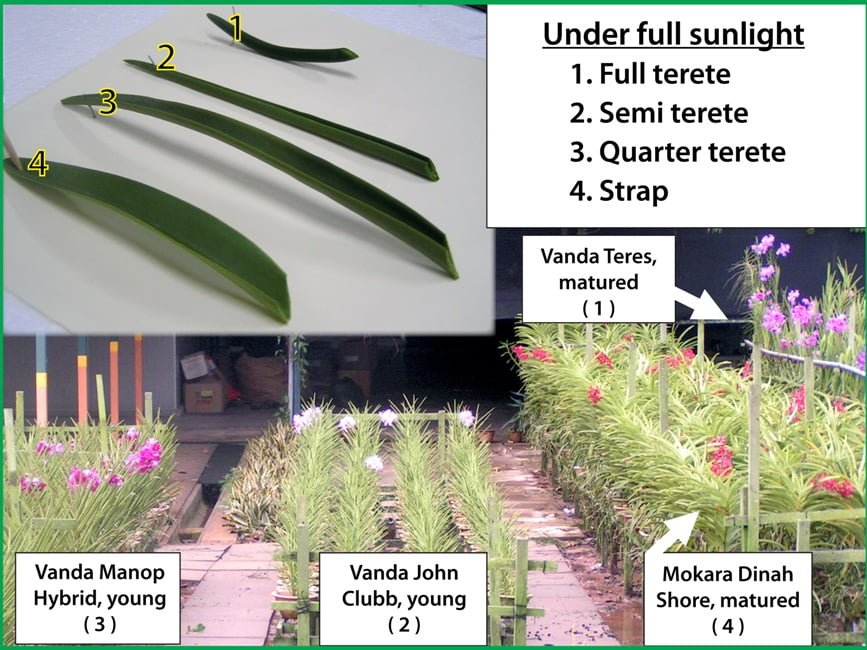
(*Note: Vandaceous orchids associated with renantheras – aranthera, yusofara, holttumara, renantanda, etc, are likely to prefer partial sunlight)
Water :
How much and how often one waters the plant would depend on the pot-medium and environmental factors. However, one rule of thumb for all Orchids still apply : watering too much is far more dangerous than watering too little. While certain Orchids prefer to be in moist medium at all times, vandaceous plants will do fine in medium that is periodically dry in a day. If watering is inadequate, the plant would look wrinkled – simply increase the frequency and/or amount for watering gradually, and plant would be back in good shape. Since vandaceous plants are typically basked in more sunlight, watering to the roots / base of the plant should be done during times of the day whereby sunlight is mild (approx. 8 ~ 10 am ; 4 ~ 5 pm ). There are several reasons for watering at such times:
(1) Maximize absorption during time of the day where the plant is actively making food
(2) Allow enough time for excess water to evaporate & not stagnant overnight
(3) Prevents “shock” to the plant – splashing a heated-up plant (especially in the mid-day sun) with cool / cold water would induce stress
Vandaceous – Advanced
The “Crown”
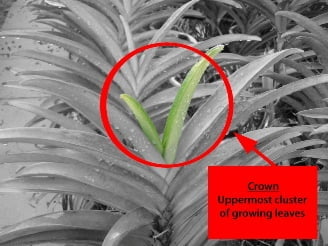 The “crown” of the vandaceous orchid is the starting point of all its vegetative growth. But if crown-rot occurs, the plant will cease to grow any further. As such, preventive measures will be highlighted and avenues to salvage the situation would be revealed thereafter. Primarily, excess moisture / water that stagnant in the crown inclines crown rot (strapped / quarter terete leafed plants are highly vulnerable). As mentioned in the basics for watering – water at appropriate times, such that excess water can be evaporated by nightfall. Not to mention, avoid watering onto/into the crown of the plant – to prevent water from accumulating in the crown; and prevent physical trauma to the delicate crown. Another drastic measure would be to absorb excess water collected in the crown with cotton / tissue – this is a especially applicable during the monsoon season where raining persist.
The “crown” of the vandaceous orchid is the starting point of all its vegetative growth. But if crown-rot occurs, the plant will cease to grow any further. As such, preventive measures will be highlighted and avenues to salvage the situation would be revealed thereafter. Primarily, excess moisture / water that stagnant in the crown inclines crown rot (strapped / quarter terete leafed plants are highly vulnerable). As mentioned in the basics for watering – water at appropriate times, such that excess water can be evaporated by nightfall. Not to mention, avoid watering onto/into the crown of the plant – to prevent water from accumulating in the crown; and prevent physical trauma to the delicate crown. Another drastic measure would be to absorb excess water collected in the crown with cotton / tissue – this is a especially applicable during the monsoon season where raining persist.
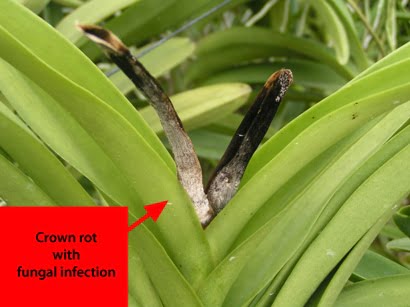 In the event of crown-rot, the crown becomes soggy and seemingly decomposed. The only remedy (or rather, damage-control) is to removed the crown completely, so that the rest of the plant does not get infected / or become a hotbed for fungus and pathogens.
In the event of crown-rot, the crown becomes soggy and seemingly decomposed. The only remedy (or rather, damage-control) is to removed the crown completely, so that the rest of the plant does not get infected / or become a hotbed for fungus and pathogens.
One way would be to pull out the infected crown, the other course of action would be to cut off the top portion of of the plant – leaving behind a stump; and treating the open wounds with fungicide.
With the lack of a crown growth, the plant’s survival instinct would be triggered, thereby producing keikis (baby plants). This is akin to methods in vegetative propagation (refer to “Producing Orchid Keikis“).
Re-potting (Top-cuts)
The managements of vandaceous keikis or top-cuts is perhaps, one of the most received queries till date. Notably, vandaceous plants take a long time to re-establish themselves in a new pot ( between 6 ~ 8 months). A recommendation would be that top-cuts should come with at least 2 ~ 3 roots. (Only in most ideal conditions – top-cuts can be planted even without roots). Given the extensive time needed for re-establishment & stabilization, it would be ideal such that the top-cut is firmly secured (kept stationary) in the new medium. The following diagram illustrates the procedures for planting a Mokara top-cut with wood-chips.
Pot mediums such as wood-chip and sphagnum moss can be compressed to increase stability – though they are prone to water retention. Pot medium like charcoal does not retain too much water, but stability of the plant’s position may be compromised. Otherwise, some may prefer a mixture of pot mediums.
_____________________________________________________________________________________________________





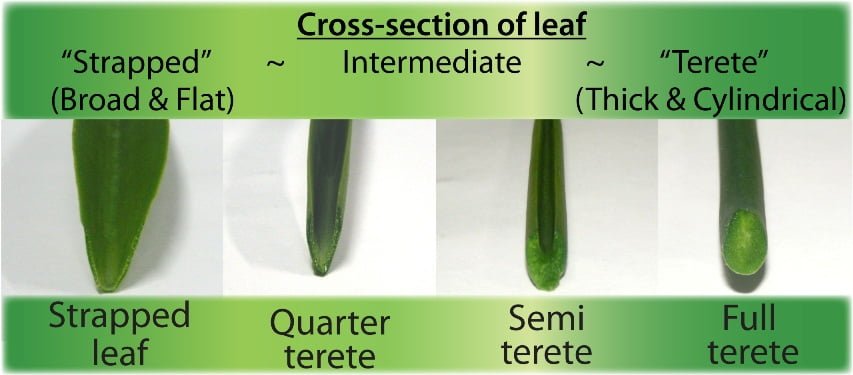
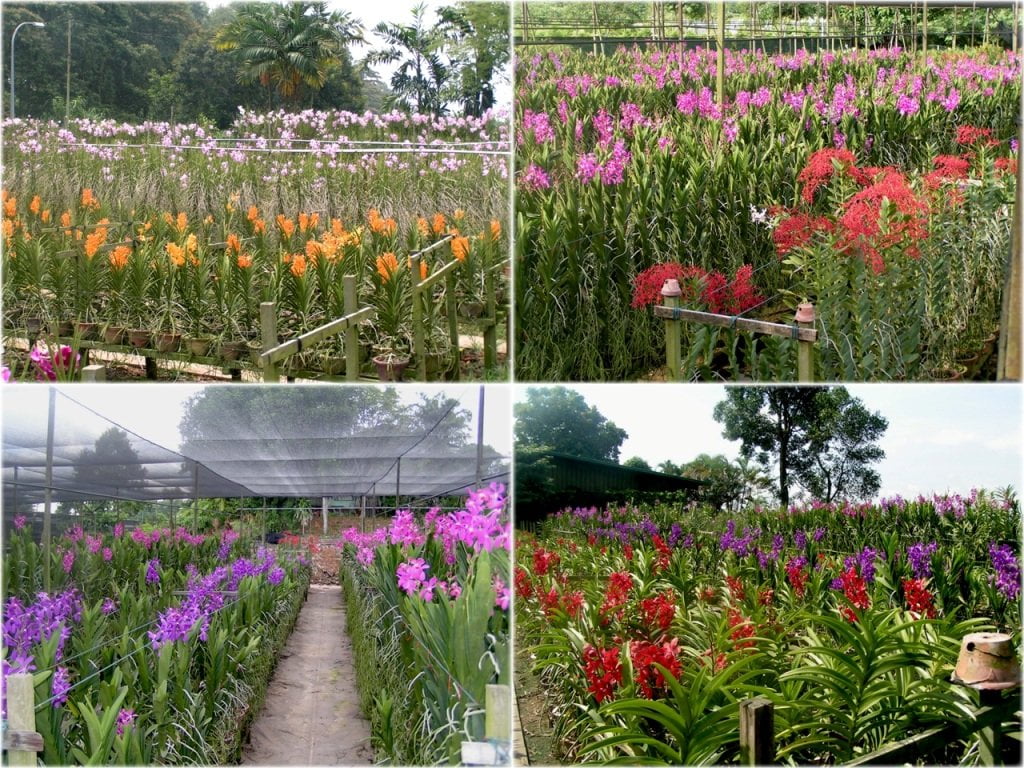
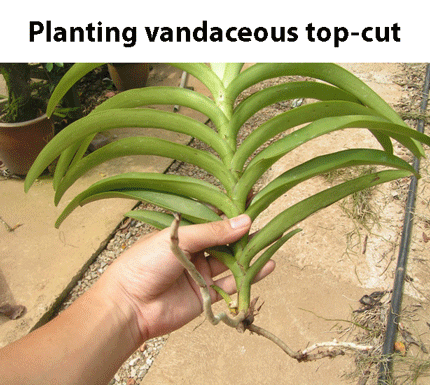
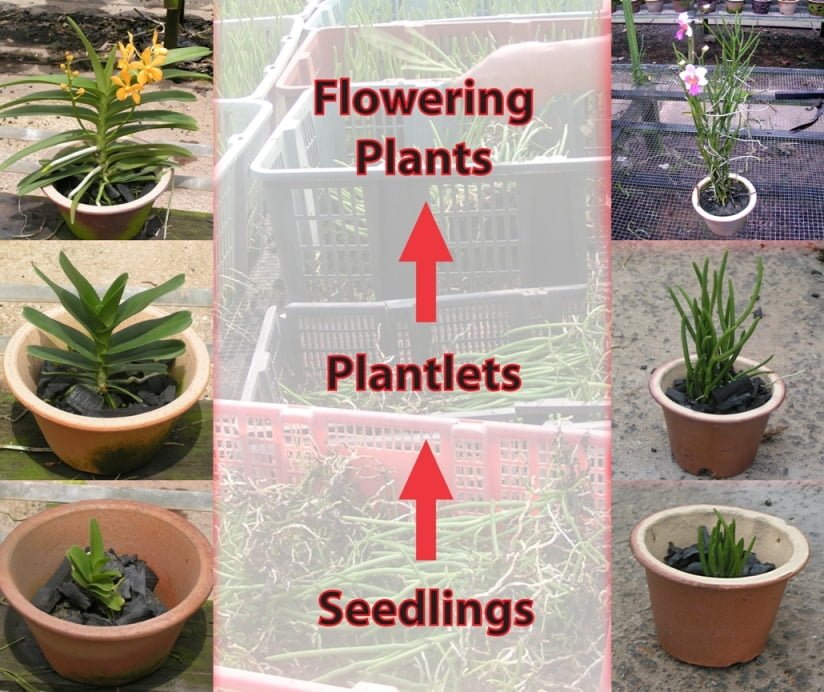
Hi,
Thanks again for your comprehensive guide on vanda growing.
I’d like to ask you one more thing.
How do you grow Oncidium? Which potting medium you used? My oncidium got rot recently.
Thanks,
Nwe
Hi Nwe,
We grow our Oncidiums in wood shavings/chips. Rot can happen due to insufficient sunlight to dry up the water in the media, bad air flow, excessive watering or incompatible media etc. Try reducing watering at the moment and spray fungicide more regularly.
Please refer to our orchid care section on pathogens for more info on how to rectify the rot.
silverelf
Hi Silverelf,
Thanks for your quick reply.
How do you water your oncidium in wood shaving? Everyday or when wood shaving becomes totally dry out? Instead of wood shaving, can I use coconut husk/chip?
Thanks in advance,
Nwe
Hi Nwe,
We water our Oncidiums every day here in nursery conditions, unless it rains or is very cloudy. For household, we recommend watering once every two to three days unless the area where you are growing it is very dry or hot. Yes its possible to use coconut husk/chips. Do note that after watering the orchids, allow the media to dry up completely before watering again, that’s the best gauge. You can feel the media for the moisture.
silverelf
Hello! Can you post a close up picture of the flowers of the Vanda Manop hybrid?
Hi angel,
Sent it to your email. =)
silverelf
Dear Sir :
During the YTL Concert of Celebration 2010 Blossoms with Vanda Orchid-Naming. The orange Vanda YTL is specially chosen to
named after YTL, do you know the real name of this orchid and where can I buy it ?
Dear Cheryl,
The original name used to be Vanda YTL, but recently there’s a shift in taxonomy naming and thus its has been reclassified under Papilionanda YTL.
This orchid is uniquely bred by the Singapore Botanic Gardens and naming rights has been gifted to YTL Corporation and thus its not available for commercial sales.
However, we have some closely related hybrids, like Vanda Tan Chay Yan and so on which are available.
You may find more information about this hybrid here:
http://www.ytlcommunity.com/commnews/shownews.asp?newsid=53333
silverelf
Hi silverelf
I bought a pot of mokara from your nursery (think it’s the Pachara Gold; all of them at a corner of the vandaceous area very near to your farm entrance).
I have it placed outdoors at the HDB balcony facing north under direct sun; almost similar conditions just like at the nursery.
I spray at it every morning and sometimes in the evening as well. It is blooming right now.
I noticed the roots’ green tips are getting smaller or slowly disappearing. I read that this is an indication of reduced growth or plant going into dormancy.
It doesn’t sound good to me. What could have gone wrong here?
Hi anony.
It is normal for old roots to go into dormancy due to senescence. However, new roots should be produced in the process.
For growing along HDB corridor or balcony, try turning your pot of orchid around at least once every month. This is to ensure that both side of the plant receives adequate sunlight as well as to keep the plant growth straight. Fertilize your orchid at least once a week with foliar fertilizers.
silverelf
Hi anony.
It is normal for old roots to go into dormancy due to senescence. However, new roots should be produced in the process. They old roots still maintain some functions by trapping nutrients and moisture within its velamen layer.
For growing along HDB corridor or balcony, try turning your pot of orchid around at least once every month. This is to ensure that both side of the plant receives adequate sunlight as well as to keep the plant growth straight. Fertilize your orchid at least once a week with foliar fertilizers.
silverelf
Hi, I have a vanda for more than 8months,still no flowering. How to induce it to flower? Recently ,it start to have yellow leaves at the base. Should I top cut it to repot? Thanks for helping
Hi Kenny,
I suppose you are talking about terete Vandas here.
Make sure that you water your Vanda regularly if its placed in full sun.
Yellowing of leaves can be due to lack of water or fertilizers.
Water every morning before 10am and fertilize at least twice a week.
If the roots are shriveled up from the bottom, or the plant gets too tall, do cut and repot them from the point with healthy aerial roots.
silverelf
Helo. I have a Vasco. Vinita Blue grown in a ‘basket’and with its roots
hanging down and exposed to the air. I have a tough time keeping it
hydrated and so, can it survive if it is grown in a pot with charcoal to
provide a more humid/wet environment? Is this particular plant susceptible
to root-rot and thus grown in a ‘basket’ in the first place?
Gd afternoon,
I hv a planter at my balcony and it is facing SW with afternoon sun.
Is it suitable to convert it to an orchid scape and at the same time acts to shield off some sunlight into my balcony ?
Thnks so much in advance,
yh
my orchid have not bloom since the flower drop.how to make the orchid bloom again?
Hi Andrew,
It depends on which type of orchid you are referring to.
Try checking out our orchid care section.
silverelf
Dear Dylan,
Yes, it is possible but I would suggest placing potted mokaras in your planters instead.
The orchids should be shifted and turned around every two weeks so that they do not grow in one direction.
(i.e. towards the balcony window).
silverelf
Hello,
Recently I lost 2 pots of Vanda Loke to crown-rot. What I don’t
understand is that 3 days before the rot, I had sprayed Thiram thoroughly.
Does this mean the Thiram has lost its effect due to tolerance of the
pathogen? Please advise.
Hello Tony,
I doubt that your Vanda Loke were lost due to crown rot particularly for the past weeks. The weather has been relatively hot and the air humidity is much lower than usual. The climate this year is very different. Its likely due to dehydration, with the plant wrinkling up and yellowing. Please correct me if I am wrong. We observe some wrinkling on our crops and have since increased watering frequency and most of our orchids have returned to healthy state.
silverelf
I have a vanda which is yellow and orange. What is the name of this type.
Hi! I have 21:21:21 / 13.5:27:27 / 15:45:15 fertilizers
at my disposal. Is it appropriate to use one with 45%
to induce specifically vandaceous orchids to flower if
they don’t respond to the other 2 formulae, suppose the
other parameters like watering and right amount of
light are met?
Hello,
I recently acquired two different types of orchids (judging by their leaf) both epiphytes, their host plant was cut down so I thought of rescuing them. I have put them into earthen pots with coco husk chunk. I water them daily in the morning; one of them is doing fine and growing rapidly. The other one which is a full terete Vanda is shrivelling. I don’t know where I am going wrong. I keep them in bright sunlight though not direct.
Please advice is anything wrong that needs to be changed…
Hi Tejashree,
The full terete Vanda is shriveling because its root systems are damaged.
Within a period of 3 months, new roots should grow from the bottom of the plant and the plant should start growing more turgid.
Keep the plant in 50% sunlight until the new roots are established.
After that you can bring the plant out into full sun for growing.
silverelf
Apologies I have no idea which Vanda you are referring to. We do not have yellow and orange Vanda at the moment.
silverelf
Which Toh Garden are you, near Orchidville or near Woon Leng? I bought some orchids from both and brought it to the Philippines.
Hi Nilo,
We are between Orchidville and Woon Leng along Lor Pasu.
We are the only orchid nursery along Lor Pasu.
silverelf
Hi Silverelf,
I’m Hapsari from Jakarta, Indonesia. I have two vandas, I dont know exactly the type but one thing for sure one has a strap leaf and another one full terete. I have been keeping them for two weeks only. When I bought them, they were all in full bloom. But, just about two days at my house the flowers had started to fell off from the strap leaf type. In one week no flowers left and now the flower stem had turn brown. Other thing that I’ve noticed from my two vandas were since three days ago their leaves are wrinkled from the bottom leave all the way to the new leaves. But, the leaves is still green and not yellow. The roots system of these two vandas, I must admit not in a very good condition. The strap leaf has many but compare to the size of the plants the roots should’ve been massive and thick, while the roots on my vanda are not. The full terete has only 3 aerial roots, even though quite thick but still didnt compare to the size of the vanda itself. I watered them twice a day. I hang them with plastic basket, the basket has many holes so the aeration wouldnt be a problem. In the afternoon because it is facing north, the sun hit them directly. Kindly help, what should I do to make the leaves normal again? And also what should I do with the roots because I didnt see any development or new growing of the roots?
Thank you so much for your help.
Hi hapsari,
Sounds like both your Vandas are having problem absorbing water and nutrients.
That’s the reason for the wrinkled leaves.
Keep watering and fertilizing them twice a week.
You should see new root growing out of them.
The turgidity of the plant will then be gradually regained.
Dear silverelf, I find difficulty in making vandaceous orchids bloom than dendrobiums. In reality is it true that vandaceous orchids are generally harder to flower because they need NPK fertilizer that is higher in nitrogen content?
How do you induce your vandaceous orchids to bloom so regularly?
Hi…Thank you so much for sharing this information.
I bought a bare root Mokara Nittha Orchid. I’m not sure its doing so well. Can I recover leaves after they have been burnt by the sun? I am struggling to find the best garden position. I was afraid it was getting too much shade (as i was advised that they love full sun). Then i moved it to a sunnier spot, and the leaves burnt in no time. Should I clip off the burnt leaves? Or?
Considering moving to a partial shade area…Do you mean under a tree (dappled sun)?
I live in the Caribbean by the way…
The fact that i have been using a black plastic pot, would that affect anything?
Dear Zhang,
The flowering yield of Vandaceous orchids are usually not as high as Dendrobiums. I would think Dendrobiums have to be fed more heavily than Vandaceous types. For the Papilionanda, they usually flower very often as long as you keep them in full sun and lesser if you provide them with lesser sun. The feeding also has to be consistent. Have you tried using our Ezi Gro NPK 24:17:17 and Ezi Gro NPK 13.5:27:27 with trace elements? These are specially formulated for cultivating orchids.
silverelf
Hi Terese,
For this Mokara, its should be cultivated under 50% to 70% sunlight. When you first brought it back to your garden, you will need to condition it under 50% sunlight first before shifting it to a more sunny place.
Its better to use clay pots to grow orchids as they are porous but plastic black will do as well. Just that it might keep toppling over if its too light.
silverelf
Hello, I live in Coconut Grove, Miami, Florida , I remember a neihgbour who had beautiful large Vandas growing in the ground in his front yard, any idea on how I can do that ?
Hi Jeffrey,
You’ll need to plant Papilionanda type of Vanda in the ground and not the Strap Leaf type of Vanda.
It should be pretty easy as long as you provide them with full sun and fertilize them regularly.
silverelf
Hi
I got a cylindrical vanda from dooars of begal n I stay at Howrah Bengal. As your plant is standing mine can’t. It was on tree branches I made it a stick with coconut husk n kept it at shade.The leaves grown yellow but reading your article kept it at our 1st floor roof since today morning its raining here n I’m a little worried for it.It’s really hot sunny sometime how to care for it!
I want it to grow healthy.I want to share pictures so u can suggest better. Please let me know if you can help.
Dear silverelf, I am a beginner in growing orchids. I had bought a vanda plant with quarter terete leaves from Toh garden about 3 weeks back. The plant was flowering with 4 bloomed flowers and had another growing flower stalk. I was told the plant only require 50% sunlight and water twice a week. In the first week I thought the sunlight may not be sufficient as I grew it indoors near window so I had place it at the hdb corridor. After a day of afternoon sun, one of the top leaves turned yellow and shriveled up and oldest 3 flowers took turn to wilt one after the other..its a sunburn? I immediately placed it back in the house near the window. While the leave continue to shrivel and turn brown,the flowers buds continue to grow bigger and bloom.by now, I am left with 2 full bloomed flowers and 9 flowers had died. I thought the growing conditions are correct now since the buds continue to grow and bloom after I moved the plant back to the house. but after the new buds at the top end grew to a certain point, they turned yellow and shriveled and now the 2 lowest leaves at the bottom are beginning to show a yellowing patch. May I know if I wasn growing it correctly or what is wrong with the plant? I watered with fertilisers twice a week.
Hi silverelf, I hope you can help me on this as I am a beginner at growing orchids.i bought a vanda with quarter terete leaves from toh garden about 3 weeks back. The plant was flowering with 4 flowers in full bloom and there was another growing flower stalk. I was advised to water twice a week and the plant only needs 50% sunlight.In the first week I had placed it by the window. However as I thought the sunlight was not enough, I placed it at the hdb corridor for 1 afternoon. At the end of the day, 1 top leaf start to shrivel and turned yellow and 3 flowers started to wilt. Its sunburn? I immediately placed the plant back in the house by the window. While the leaf shrivelled and turned brown, remaining buds continued to grow and bloom. By now, there are 2 full bloomed flowers and 9 flowers have wilted. I thought the growing conditions are correct as the flowers buds continued to grow and bloom,. However the top flower buds grew to certain size and turned yellow just a few days ago. Now 2 bottom leaves are showing yellowing. May I know what wasn done correctly or what is wrong with the plant?
Hi, just to add on that I have been watering the plant with ezi gro twice a week.
Dear Ishita,
The cylindrical Vanda you mentioned can usually take alot of sun.
Its either a Papilionanthe or a Papilionanda genus orchid.
We grow these under full sun and water them everyday (morning/evening) and fertilize them twice a week.
These are terrestial orchids, they do better when grown on the ground than hanged up unlike strap leaf Vandas.
silverelf
Dear Huimin,
Quarter terete Vandas (Papilionanda) can take 50% to full sun.
Its our local kind of orchid that loves tropical weather and doesn’t mind the heat!
Its not good to keep them indoors.
Place them somewhere where there’s lots of sunlight.
In fact, the more sunlight it receives the better it grows and flowers.
The bottom leaves turning yellow and shriveling are evident that the bottom part of the plants are not receiving enough sunlight.
silverelf
I WANT TO YOUR MINIATURE POTTED ORCHid plants At least 10 – 15 differnt types of potted orchid plants. Please let me know the cost of each orchid
plant including delivery cost A S A POSSIBLE2
Hi
I had bought two pots of orchids at your garden on Sunday 6th Dec. I was told by the gardener that one is called Chua Chu Kang and the other one is a species given to president Obama. May I know their exact names and species so I know how to take care of them.
Hi Henry,
Apologies for the belated reply.
For sales, please email or contact us directly via email or phone.
For miniature potted orchids, it will be $8 each and delivery of $25 applies.
Prices exclude GST.
Thank you.
silverelf
Hi Ms Goh,
I’ve replied you on your previous comment.
For cultivation of Papilionanda, please refer to http://tohgarden.com/orchid-care/vandaceous/
The type you’ve purchased is quarter-terete Vanda
Thank you.
silverelf
Hi, I bought a pot of red coral vanda orchid around Chinese New Year. Has been watering every 2-3 days and it is exposed to morning sun. The flowers started withering after 1 month and the leaves at the bottom started turning light green. do you know why the flowers are withering and leaves turning light green?
Hi Vivien,
Flower are living things, its natural for them to wither after a month but the orchid will reflower again if its a tropical variety. Note that not all the orchids sold during Chinese New Year by vendors are locally produced orchids, thus it depends on what kind of orchid you have on hand. For those that comes from the temperate region, you may be able to grow them here but they may not flower in the tropics as they require winter treatment.
silverelf
Hi, am new to this site and had just pick up Orchid gardening, but I am planting those mounted types. Want to know if Vandaceous orchids can be mounted. Thanks.
Love you thread. Not too long ago I purchased two renanthera orchids from the International Orchid Festival and I mounted them on an indoor palm. I water them twice a day, once in the morning and once at night (which after reading your advice I wont water it at night anymore. I will change the night time watering for when I get home from work before sunset).
The roots are all dry but the leaves are perfectly green. I don’t want them to die, should I leave it mounted on the palm or should i re-pot. Any advise?
Hi Fred,
Yes, Vandaceous orchids can be mounted. However, it should be frequently misted.
silverelf
Hi Miami Orchid Mom,
Its likely not due to watering issue. Renanthera require more light, planting them indoor will deprive them of light required for their growth. Try shifting it somewhere outdoors with some shade. You should observe new root growth within the next 3 4 months.
silverelf
HI,
I’ve recently bought a Vanda Miss Joaquim from you guys. Just wondering what are the care I should provide? Namely the big 3. Sunlight, watering and fertilizing frequency requirements?
Thanks a lot
Hi Yap,
1. It can take full sun.
2. It can take watering daily if you are planting it in full sun environment where air flow is good.
3. It should be fertilized at least twice a week under these conditions.
silverelf
Hi.. how many times to watering the dendrobium if new repotting with coconut..? And also the phalaenopsis. Can i put the fitilizer if new potting..
Hi Beth,
Water only when the media has completely dry out.
Its the same for all planting media.
Depending on the type of media you use, e.g. sphagnum moss will take longer to dry out, charcoal will dry out very quickly.
You can feel the media.
Yes, fertilizers can be applied after repotting.
silverelf
Hi
Recently I got some mokara . but most of them are without root. They in the top with coconut husk. Can you please tell me how can I stimulate to grow root? They are at now in under shed. Should I spay water on their body? I am from Bangladesh it is hot 30-32 degree C and Humidity 80%+
Any suggestion pls.
Hi Manjur,
Place the Mokara under 50% sunlight and take care of it as per normal.
It should produce new roots within 3 months.
silverelf
Hi. I have just bought a few pots. Some are flowering while some are plantlets. Is it ok to repot them specially the flowering ones as the pots are not stable.
Hi Payal,
Yes of course you can repot them.
However, the flowers may not last as well after the repotting if there are damages to the roots.
silverelf
Hi,
I bought an ascocenda orchid with small orange blooms from your garden last week.
It’s root tips are black and there are some black spots on some leaves. Some flowers are starting to fall off. What is wrong with it?
It is hung indoor under full-speed ceiling fan during the day and exposed to full sunlight from full glass window. What should I do?
Thanks.
Hi newbie,
Ascocenda should be grown at 50% sunlight only, not full sun.
The leaves can get leaf burns from the full sun exposure.
High speed fan can dehydrate the flowers fast, so make sure to water/mist the plants frequently if you intend to put them under the fan.
silverelf
Hi must I water my vanda orchids before fertilizing it
Hi Johnny,
yes, its better to water before fertilizing..
silverelf
I suspect my vandas has the ‘FUSARIUM’disease.How should i treat them.thanks
Hi Ms Ong,
You’ll have to apply a fungicide.
Thiram, Benomyl etc.
silverelf
My friend gave me some orchid seedling – V Prayad Muang Rath-Lenakamol Phun x V Sanderiouna. Do you have a photo of this plant or the parent plants? Where can I look up for their photos?
Please help
Hi Adam,
This is a new hybrid from seedpod.
You can only get photos of it when it blooms. =)
silverelf
Hi,
1. Can I spray Vanda’s leaves?
2. Just got a Mokara with wood moss and advised to water once a week only. Is it correct?
Hi, I have a north facing balcony with no sun ray reaching there. I have erected a shelf for my orchids which mostly are dendrobiums, vandas, Ascocenda, Vanda and phalaenopses. I am using a shade net as I found the leaves of the dendrobiums turning yellow. Now I have repotted most of them and I wish to know if my set up is fine enough to induce flowering. I will be grateful for your advice. Thank you.
Mini
Hi Mini,
If you have no sun ray reaching there, there’s no need for netting.
Its likely the light is already insufficient, so placing a netting will further reduce the amount of light that your orchid gets.
Trying removing the nettings or moving the plant to somewhere with more light so they can make more food (from the sun) =)
silverelf
Hi Mini, If you have no sun ray reaching there, there’s no need for netting. Its likely the light is already insufficient, so placing a netting will further reduce the amount of light that your orchid gets. Trying removing the nettings or moving the plant to somewhere with more light so they can make more food (from the sun) =) silverelf
Hi Silverelf,
I recently bought a ambrosia twinkle from toh garden, it has been 2 weeks now.
The flowers are orange however i notice that the new flower buds that open has yellow flowers.
Is there some deficiency or area i should look into.
Hi! I recently purchased a cutting and a pot of V. Tan Chay Yan (a week ago). Would like to know the sunlight requirements of the plant as currently the mature flowering pot is placed in location that gets sun from 9-11.30 and in shade thereafter. The cutting is potted with charcoal and in full sun from 0830-1400 with no shade. Both are watered/mist twice daily and well-ventilated. Thanks for any advice!
[…] http://tohgarden.com/orchid-care/vandaceous/ […]
Hello Jeremy,
Try growing the plant under more sunlight and remember to fertilize it.
Pda. Ambrosian Twinkle blooms easily in our climate.
silverelf
Hi Ivan,
Your growing conditions are fine.
Pda Tan Chay Yan can grow in 50% shade to 100% sun.
More sunlight = higher frequency of flowering.
Water and fertilize regularly and it will bloom well.
silverelf
Great site, I live in Miami, Fla. starting to get into “Vandas” can I hang them in roof overhang getting direct sun till about 11:45am? I will water them everyday and fertilize regularly, mind in you in summer it gets really hot here, thanks in advance.
Hi, I bought a few pots of the vanda miss joaquim 1.5 years ago and they have now more than doubled its height to more than 2 m tall and thick. But no flowers. its in full sun, fertilized with the fertilizer for orchid flowering but not a single bloom. keeps growing taller and taller, sign that its quite happy? What should I do to get it to bloom?
Please mail me how to pot new mokara plants
Can I use coconut pith along with charcoal and broken tiles
I have bought 2 new plants
Expecting your help
I am from Kerala South India
Regards
Hello!
I’ve read the whole of the comments section with great interest, really appreciate how comprehensive the info is and how forthcoming you are. I’d like to know why root tips (Vanda) would start to turn brown? And if misting is adequate, vs full on dousing with water. Living in Singapore, orchids get indirect sunlight from about 3pm, misted early morning before sunrise. No full sun, plenty of ventilation, roots are hanging and exposed, tiny plastic basket. Leaves looking a bit wrinkly this week, flowers in bloom for the last three weeks (since buying them in bloom). I bought a random orchid fertiliser from general post office at Eunos- one for twice a week, the other twice a month. So I mist with water and then mist with dilute fertiliser solution. What do you think? Any ideas re root tips? Thanks in Advance!
Hi Safira! Thanks for the query! There are several factors as to why roots turn brown. They could be sick or simply aged. You’ll need to check the condition of new roots (if any) to get a better gauge of the plant’s health. Healthy roots are thick with green tips. Will need to see photos of the plant and check with the gardener. Wrinkled leaves could be a sign of underwatering. To check if the plant is getting enough water, you can feel the leaves. Turgid leaves that snap with a crunchy sound when bent means it is receiving enough water. Limp or soft leaves that bend without breaking means the plant needs more water. Misting is fine but you’ll need to spray thoroughly until the roots are wet. Fertilising is also fine. With enough water and sunlight, new roots will grow. You can also send photos of the afflicted plant to [email protected]. Happy Gardening!
Hi Revi! Yes, its fine to use a mixture of media as long as it has good drainage. If you are keeping the plants indoors, it might not be necessary to water every day with coconut pith as the media. To be sure, check the potting media before watering again.
Hi Humberto! Apologies for the delayed response! I suppose it would depend on the type of Vanda you have. Terete-leaf Vandas love full direct sun, whereas Strap Leaf Vandas prefer some shade. If the orchids seem to be a little burnt, you could shift them closer towards some shade. Most of our Vandas are growing between 70 – 100% sun and we do water them everyday as it gets hot (26 – 32 degrees) here as well.
Hello Benita,
You will need to fertilize the plants as well.
Try using more Ezi Gro 67 fertilizers than 63.
Joaquim flowering is easy to grow but the flowering is seasonal.
It blooms twice a year but each flowering period should last about 2-3months in Singapore.
silverelf
Hi Anna,
Thanks so much for replying! I’ve just visited your booth today at United SQ (maybe that was you I spoke to? Along with Abu?). I’m going to increase watering, I do spray til it’s dripping wet, perhaps it isn’t enough. Abu mentioned they don’t require full sun so I’ve brought them back in to my little utility balcony which gets indirect bright sun around 3pm. I’ve noticed some new huge roots growing! Possibly result of all the rain!
More questions: when I fertilise, do I spray the roots with plain water first, and then follow with dilute fertiliser solution? And again, till dripping wet?
I’ve just bought two orchids from you, that are said to be happy with full sun, sadly I forget their names, I hope I can keep these ones thriving. I’m on the 25th floor, will the orchids get annoyed with the wind?
Here’s to turgid leaves!
-Safira (the reluctant orchid killer)
Hi Safira! Thank you for dropping by the booth! It was nice talking to you too! Glad to hear the plants are growing well. On days when applying fertiliser, we do not recommend watering again as this will result in the plant absorbing too much water. You can refer to this page for more info: http://tohgarden.com/orchid-care/fertilizers/ Wind in our humidity shouldn’t be an issue for the orchids, they like good ventilation! Do secure the pots though;) You can email us a photo of the orchids that need names. All the best and happy gardening!
Hello, thank you for the informative guide on orchid.
I have just bought 2 Vanda terete and will like to ask if i can hang them on the edge of my patio shelter. Sunlight is partially filtered thru a polycarbonate shelter screen and exposed to rain. Thanks!
Hi, also to add that my 2 Vandas do not have media and is placed in a hanging plastic basket.
Hello GC,
Thank you for your support.
Yes, you can hang them on the edge of your patio.
However, terete Vanda are best grown with more sunlight.
With lesser sunlight, the plant grows and produce flowers slower.
If you hang them by the patio, remember to turn the plants around every 2-3 weeks so the plant maintains its straight stature.
silverelf
Hello GC,
Hanging Vandas do not require media if they are ephiphytes.
However, you do need to fertilize and water them regularly.
silverelf
I recently obtained a pot of Vanda orchid from a friend. It has long pointed quarter terete leaves. The plant was initially placed at a spot which receives sun from 2 pm onwards. However, the flower bud turned brown and died after 2-3 weeks. I thought it could be due to insufficient light and transferred it to another spot which gets almost full day sun. However, the leaves at the bottom turned yellow and looked dehydrated. May I know what have I done wrong?
To add on to what I have mentioned, I watered the Vanda orchid twice a day and feed it with ferilisers twice a week.
Hi can we get young Vanda orchid plant at your place and if is available how much is the cost?
Thks You!
Hello Mr Khoo,
Yes you can do so, $35 for full pot, $15 for a cutting.
silverelf
Bonsoir, est-ce que vous livrez sur l’île de la Réunion s’il vous plaît merci.
Oui
Hi,
I’m considering orchids for my outdoors. I get sun from 10am all the way until about 2 – 3pm, with full 12 noon sun. It’s also quite hot, but there are other plants clustered outdoors. Could you recommend plants that would work for that type of climate?
Hi Gwen,
You can try growing Papilionandas.
They do well in hot full sun.
silverelf
Are the hours of the sun enough for them? I also saw that you carry the Mandai Poppet, are there other Papilionandas that you carry?
Do you sell fertilisers for Varna joachim
Hi Poh Cheong,
Yes, we do sell fertilizers for orchids.
You can order it via our Lazada shop https://www.lazada.sg/shop/toh-garden/ if you are just ordering small items to save on logistics.
silverelf
Hello silverelf,
How often should I water and fertilize orchid seedlings in charcoal medium??
I recently got the vanda miss joaquim.
Thanks in advance.
Hi Alex,
You should water them after the media dries up, thus it can depends on the environment that you are growing the plant.
Fertilizing should be done twice a week.
silverelf
Hello Silverelf,
Thanks for the reply. Can I just check; do you still sell the Vanda Mimi Palmer and the Oncidium Sharry Baby?
Medium require for vanda orchids
I have a Margaret Tan vanda and, for whatever reason don’t seem to be able to care for it adequately. It’s leaves are green but they are all closed up and shrivelled.
Upon delivery of some new vandas (that I hope I can look after better), the delivery man (with my approval) pruned it so now there are top cut and even middle section re-plants. These continue to look shrivelled with the original top cut retaining flowers but they are withering too.
What have I done wrong to get into this situation and is it realistic to expect I can retrieve these offshoots ?
I also don’t understand the feeding regimes. They seem to be more frequent than watering regimes yet they are applied with water. Doesn’t that result in over watering ?
With the new vandas. In Singapore, in daylight but not full sun, how do I keep them healthy. When do I water, when do I feed etc ?
Yes, we do Alex
Hi Robert,
Papilionanda Margaret Tan prefers full sunlight.
If you growing from a top cut, there’s a tendency for the plant leaves to shrivel before new roots are grown as it can’t absorb water well.
It will take around 3 months for new roots to establish proper and the shrivel leaf condition will improve.
A general guideline on watering, water and allow the media to dry out completely before watering.
Feeding is generally done twice a week, however if your media is still wet before your next feed, you can reduce the feeding as its likely you are growing under reduce sunlight.
There’s no need to apply so much fertilizers in this case.
Thank you.
silverelf
Hi John,
Vanda can be grown in hanging basket with medium.
They can also be grown in pot with charcoal or pine bark.
silverelf
Hi Silverelf,
I read from the Toh garden guide that Vandas can handle between 70-100% light. The vandas I have have strap leaves and I recently setup a orchid rack with nettings on top. However, the plants are exposed 100% to the morning sun which can be hot. Do I have to be concern about burn marks or just observing them and add netting as required?
Hi Dave,
Strap leaf Vanda cannot take full sun, they need 50%-70% sunlight.
Papilionanda can take full sun.
silverelf
Hi
I just bought v.somsri ping x suksamran spot. Hanging n without medium. I forgot to asked how often to water coz I do heard from somewhere Vanda need lot water especially when on hanging without any medium. Thanks.
Hi Fernando,
Yes, it will be good to water the hanging Vanda daily, and fertilize it twice a week.
The roots must be allowed to dry before watering again.
Thank you.
silverelf